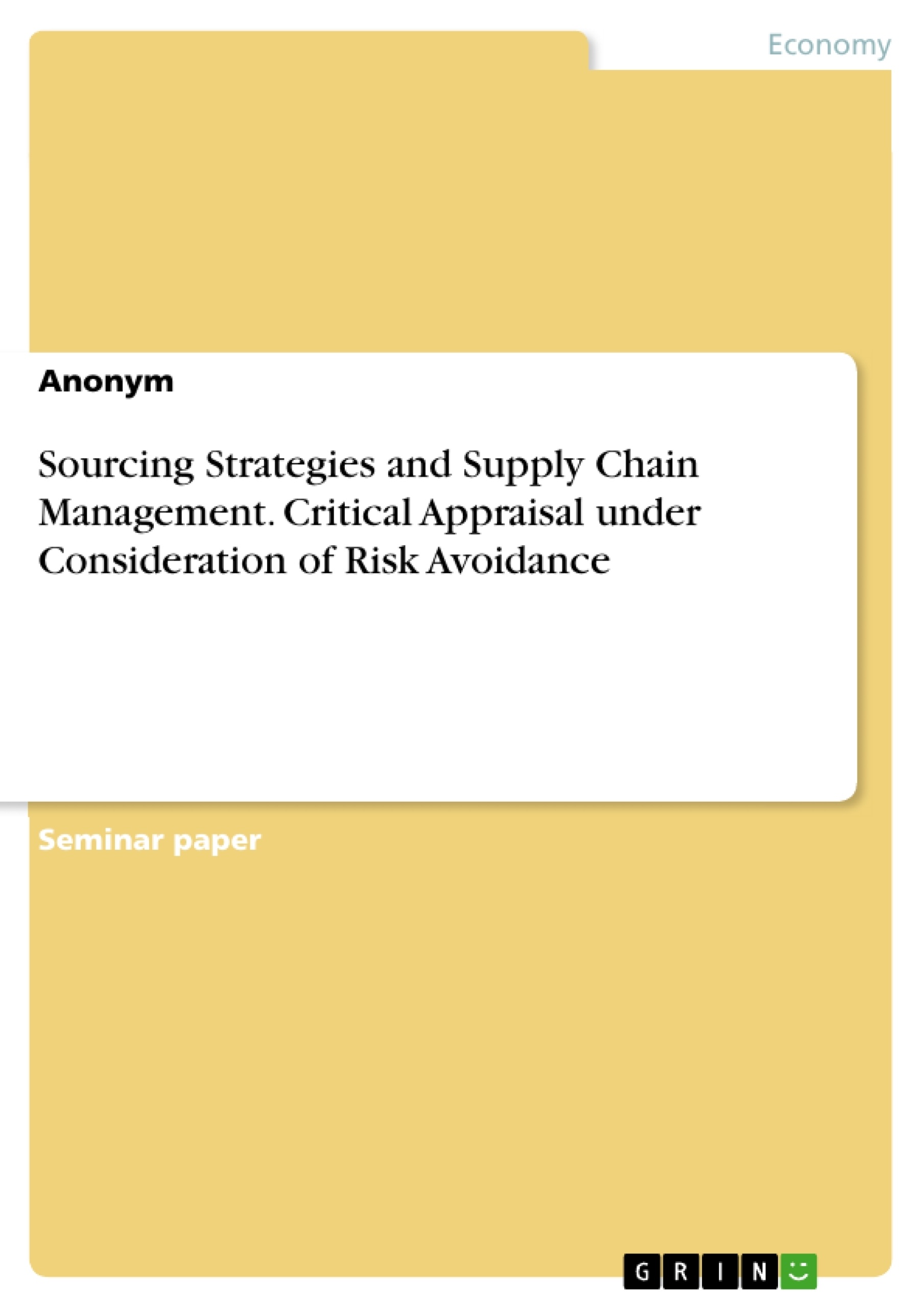This coursework focuses on strategic sourcing and does not take the other elements of a supply chain into consideration. The risks identified are based on the element of sourcing. Only external sourcing strategies are considered, which belong to supplier strategies.
The definition of supply chain management has brought up by two consultants in 1982. Today, it’s more challenging than ever for the management of companies to developed and implemented coherent strategies to manage and coordinate supply chains and to minimize the likelihood of risks.
Table of Contents
- 1 Introduction
- 2 Sourcing
- 2.1 Definition of sourcing processes
- 2.2 Definition of sourcing strategies
- 2.3 Overview of the selected sourcing strategies
- 2.4 Appraisal of the selected sourcing strategies
- 2.4.1 Single sourcing
- 2.4.2 Dual sourcing
- 2.4.3 Multiple sourcing
- 2.4.4 Modular sourcing
- 2.4.5 Local sourcing
- 2.4.6 Global sourcing
- 2.5 Summary of the selected sourcing strategies
- 3 Supply chain risk management
- 3.1 Identification of financial and non-financial risk areas
- 3.2 Risk avoidance
- 4 Conclusion
Objectives and Key Themes
This coursework aims to provide a critical appraisal of six sourcing strategies – single, dual, multiple, modular, local, and global sourcing – within the context of supply chain risk management. The analysis considers both financial and non-financial aspects of each strategy, with a particular focus on risk avoidance. The study utilizes existing frameworks for understanding supply chain risk and sourcing processes to provide a structured and comprehensive evaluation.
- Critical evaluation of various sourcing strategies
- Analysis of financial and non-financial advantages and disadvantages of each strategy
- Assessment of risk avoidance in the context of different sourcing strategies
- Application of established supply chain risk management frameworks
- Exploration of the interplay between sourcing strategies and supply chain risk
Chapter Summaries
1 Introduction: This chapter introduces the concept of supply chain management, highlighting the increasing complexity of coordinating supply chains and minimizing risks. It establishes the focus of the paper on sourcing strategies and their impact on risk avoidance. The chapter introduces the five elements of a supply chain (planning, sourcing, making, delivering, and returning) using the SCOR model, clarifying that the study will concentrate solely on the sourcing element and external supplier strategies.
2 Sourcing: This chapter delves into a detailed analysis of six different sourcing strategies. It starts by defining sourcing processes and strategies before providing an overview of the selected strategies: single, dual, multiple, modular, local, and global sourcing. Each strategy is then individually appraised, examining its financial and non-financial implications. The chapter concludes with a summary that synthesizes the comparative advantages and disadvantages of each strategy.
3 Supply chain risk management: This chapter identifies key financial and non-financial risk areas associated with sourcing. It explains the importance of risk avoidance strategies within supply chain risk management and utilizes the Locker and Grosse-Ruyken (2013) framework as a basis for analysis. This chapter establishes the critical link between the sourcing strategies analyzed in Chapter 2 and the potential risks involved, laying the groundwork for a holistic risk-informed approach to sourcing decisions.
Keywords
Sourcing strategies, supply chain risk management, risk avoidance, single sourcing, dual sourcing, multiple sourcing, modular sourcing, local sourcing, global sourcing, financial risk, non-financial risk, strategic sourcing, supplier strategies.
Frequently Asked Questions: A Comprehensive Language Preview
What is the overall focus of this coursework?
This coursework provides a critical appraisal of six sourcing strategies (single, dual, multiple, modular, local, and global sourcing) within the context of supply chain risk management. The analysis considers both financial and non-financial aspects, with a focus on risk avoidance, using established frameworks for understanding supply chain risk and sourcing processes.
What sourcing strategies are analyzed?
The coursework analyzes six sourcing strategies: single sourcing, dual sourcing, multiple sourcing, modular sourcing, local sourcing, and global sourcing. Each strategy is appraised individually, examining its financial and non-financial implications and its contribution to risk avoidance.
How are the sourcing strategies evaluated?
The evaluation considers both financial and non-financial advantages and disadvantages of each strategy. It assesses risk avoidance within the context of each strategy and applies established supply chain risk management frameworks to provide a structured and comprehensive evaluation.
What is the role of supply chain risk management in the coursework?
Supply chain risk management is central to the analysis. The coursework identifies key financial and non-financial risk areas associated with sourcing and explains the importance of risk avoidance strategies. It utilizes the Locker and Grosse-Ruyken (2013) framework to analyze the link between sourcing strategies and potential risks.
What are the key themes explored in the coursework?
Key themes include critical evaluation of various sourcing strategies, analysis of financial and non-financial aspects, assessment of risk avoidance, application of supply chain risk management frameworks, and exploration of the interplay between sourcing strategies and supply chain risk.
What is the structure of the coursework?
The coursework is structured into four chapters: an introduction outlining the context and scope; a detailed analysis of the six sourcing strategies; an examination of supply chain risk management; and a conclusion summarizing the findings. A table of contents and chapter summaries are provided.
What are the key terms or keywords used in this coursework?
Keywords include sourcing strategies, supply chain risk management, risk avoidance, single sourcing, dual sourcing, multiple sourcing, modular sourcing, local sourcing, global sourcing, financial risk, non-financial risk, strategic sourcing, and supplier strategies.
What model is used to explain the supply chain elements?
The SCOR model is briefly introduced to explain the five elements of a supply chain (planning, sourcing, making, delivering, and returning). The coursework focuses solely on the sourcing element and external supplier strategies.
What is the intended audience for this coursework?
The coursework is intended for academic use, facilitating the analysis of themes in a structured and professional manner.
- Quote paper
- Anonym (Author), 2021, Sourcing Strategies and Supply Chain Management. Critical Appraisal under Consideration of Risk Avoidance, Munich, GRIN Verlag, https://www.grin.com/document/1150126



